Mytilus trossulus Gould, 1850Common name(s): Pacific blue mussel, Northern bay mussel, Edible mussel, Foolish mussel |
|
| Synonyms: Mytilus edulis (in the northern Pacific. True M. edulis is apparently found only in the Atlantic) |  |
| Phylum Mollusca
Class Bivalvia Subclass Pteriomorphia Order Mytiloida Family Mytilidae |
|
| Mytilus trossulus from Rosario Bay, WA | |
| (Photo by: Dave Cowles August 2005) | |
How to Distinguish from Similar Species: Mytilus californianus is similarly shaped but is usually even more elongated, has coarse radiating ribs, often has an eroded surface, grows much larger, and is most common on the outer coast. Horse mussels such as Modiolus modiolus usually have dark brown , hairy periostracum. This species is very difficult to distinguish morphologically from M. galloprovincialis, which is found from San Francisco south, and from M. edulis, which is found in the Atlantic Ocean.
Geographical Range: North of San Francisco to Arctic Ocean (Historically the range extended much farther south to Baja California. Southern end of range is probably contracting due to competition with the mediterranean mussel Mytilus galloprovincialis--see more below on this). Populations of very similar mussels are also found in Japan and Australia, but I do not know whether these are of this species or of one of the very similar-appearing species. Likely also on the Russian Pacific coast. Some populations occur in the North Atlantic from Cape Hatteras to Hudson Bay and from northern Labrador to the northern Gulf of Maine.
Depth Range: Intertidal to 40 m; wharves, docks, pilings
Habitat: Mostly quiet bays. Said to be found also on open coast in mixed populations with M. californianus.
Biology/Natural History: Mussels such as these attach by byssal threads and are often found in clusters. In the photo above the byssal threads secreted by this mussel can be seen on the ventral (lower) side, and several other byssal threads by which other mussels had attached to this one are visible on the side and the dorsal surface of the shell. Besides looking almost identical (they can be distinguished mainly by molecular means), the ecological requirements of this species seem to be very similar to that of Mytilus galloprovincialis, the Mediterranean or southern bay mussel, except for a few differences. Presumably M. trossulus favors cooler water, and my observation has been that M. trossulus is less tolerant of the strong wave action of the open coast than is M. galloprovincialis. Both these species are said to occur in mixed populations with M. californianus on the open coast, and I have observed this in S. California. However, it appears to me that very few M. trossulus grow on exposed sites on the open coast. I believe that the small, smoother mussels seen on the open coast of Washington along with the larger M. californianus are almost always simply young M. californianus rather than M. trossulus. I base this conclusion on the observation that M. californianus are usually more elongated with a more pointed umbo than is M. trossulus. This conclusion needs to be tested by more definitive means, such as by molecular analysis.
Bay mussels filter feed almost continuously, mainly on detritus particles but also on plankton down to 4-5 microns. Detrital particles sloughed off kelps such as Laminaria and Agarum seem to lead to the highest growth rates. They capture food on mucus sheets on the gills, but can sort and reject some particles. They can likely also absorb dissolved organic materials directly from the water. During blooms of the dinoflagellate Alexandrium catanella, which blooms at sea temperatures exceeding 13C, this species may accumulate toxic levels of the paralytic shellfish poisoning (PSP) toxin. Unlike the butter clam Saxidomus gigantea which also accumulates the toxin, after the bloom is finished this species rapidly purges its tissues of the toxin. Therefore it is one of the indicator species used to test for the presence of PSP. Pumping rate is up to 2.5 liters/h per gram of body weight. Predators include seastars such as Pisaster ochraceous, Leptasterias hexactis, and Pycnopodia helianthoides, anemones such as Urticina crassicornis and Anthopleura xanthogrammica, oyster drills such as the frilled dogwinkle Nucella lamellosa, large crabs, diving ducks, pile perch, shiner perch, surf scoters, black oystercatchers, Barrow's goldeneyes, gulls, crows, sea otters, and mink. It sometimes defends itself against oyster drill whelks by gluing a byssal thread to the whelk and to a nearby rock, thus tethering the snail to the rock until it starves. Byssal thread formation is inhibited by mercury and copper so this species does not live where these pollutants occur. The gut may contain the parasitic copepod Mytilicola orientalis. In Puget Sound they spawn in April and May. Larvae are planktonic veligers for 4-7 weeks. They settle into areas with filamentous algae, byssal threads, hydroids, Semibalanus cariosus, or bare rock. Adults live 2-3 years in California, probably longer farther north.
This species is probably referred to as the foolish mussel because of the large clusters which sometimes formed, attached weakly to one another by byssal threads. The cluster can become so large and the attachment to the rock so weak that the entire cluster breaks off and washes away, often into the waiting mouths of predators.
Note: Most references to bay mussels before 1990
refer to M.
edulis. However, it has not been concluded from
molecular analysis
that M. edulis does not occur on our Pacific
coast. Past references
to M. edulis should usually be taken to refer to M.
galloprovincialis
if the location is south of San Francisco, and to M. trossulus
if
well north of San Francisco. The two species appear to by
hybridizing
just north of San Francisco, and M. galloprovincialis
is extending
its range northward. M. galloprovincialis
is being commercially
cultivated in Puget Sound, and a population of M. edulis
has been
introduced to Georgia Strait so further hybridization will likely
occur.
Elliott et al. (2008) report that by the time of their study, M.
galloprovincialis and hybrids between M.
galloprovincialis and
M.
trossulus occurred throughout the Puget Sound and Rosario
area.
Compared to M. trossulus, M.
galloprovincialis and hybrids
between the two were more common on docks rather than intertidally, and
if intertidal were more common lower in the intertidal than was M.
trossulus.
The two species appeared to be mating randomly with one another.
McCartney and Lima (2011) state that there are at least
some barriers to hybridization between M. trossulus and M. edulis.
M. trossulus is now known to also occur in several populations in northern Europe, including Norway and Russia (Väinölä and Strelkov, 2011).
On the open coast this species is more susceptible to predation by the snails Nucella emarginata and N. canaliculata than is the larger Mytilus californianus (Wootton, 2002)
A study done on the related species Mytilus edulus (from the Atlantic) found that the movements of individual mussels correspond to a Lévy walk pattern rather than a ballistic or Brownian pattern. This resulted in creating clusters with small-scale crowding, along with larger-scale dispersion. In this pattern mussels maximized the number of mussels immediately close to them (which reduced their chance of being dislodged by wave action) while at the same time minimized the number of mussels in the general area (which would increase competition for food). [de Jager, Monique, Franz J. Weissing, Peter M. J. Herman, Bart A. Nolet, and Johan van de Koppel, 2011. Lévy Walks Evolve Through Interaction Between Movement and Environmental Complexity. Science 332 pp 1551-1553. A commentary on the article is on page 1514 of the same issue]
| Return to: | |||
| Main Page | Alphabetic Index | Systematic Index | Glossary |
References:
Dichotomous Keys:Flora and Fairbanks, 1966 (as M. edulis)
Kozloff 1987, 1996 (as M. edulis except in addendum)
Smith and Carlton, 1975 (as M. edulis)
General References:
Brusca
and Brusca, 1978 (as M. edulis)
Carefoot,
1977 (As M. edulis)
Harbo,
1997
Harbo,
1999
Johnson
and Snook, 1955 (as M. edulis)
Kozloff,
1993 (as M. edulis, with correction)
McConnaughey
and McConnaughey, 1985 (as M. edulis)
Morris,
1966 (as M. edulis)
Morris
et al. 1980 (as M. edulis)
Niesen,
1997
O'Clair
and O'Clair, 1998
Sept,
1999
Scientific Articles:
Beaumont, A.R.m, 1994. Linkage studies in Mytilus
edulis,
the mussel. Heredity 72: 557-562
Borsa, P., C. Daguin, S.R. Caetano, and F. Bonhomme, 1999. Nuclear-DNA evidence that northeastern Atlantic Mytilus trossulus mussels carry M. edulis genes. Journal of Molluscan Studies 65: 504-507
Carrington, Emily, Gretchen M. Moeser, Sean B. Thompson, Laura C. Coutts, and Carrie A. Craig, 2008. Mussel attachment on rocky shores: the effect of flow on byssus production. Integrative and Comparative Biology 48:6 pp 801-807
Comesa AS, Toro EJ, Innes DJ, Thompson RJ (1999) A molecular approach to the ecology of a mussel (Mytilus edulis- M. trossulus) hybrid zone on the east coast of Newfoundland, Canada. Marine Biology 133:213-221
Elliott, Joel, Kathleen Holmes, Rachel Chambers, Kate Leon, and Peter Wimberger, 2008. Differences in morphology and habitat use among the native mussel Mytilus trossulus, the non-native M. galloprovincialis, and their hybrids in Puget Sound, Washington. Marine Biology 156: 39-53
Gardner JPA (1992) Mytilus galloprovincialis (Lmk) (Bivalvia, Mollusca): The taxonomic status of the mediterranean mussel. Ophelia 35:219-243
Geller JB, Carlton JT, Powers DA (1994) PCR-based detection of mtDNA haplotypes of native and invading mussels on the notheastern Pacific cost: latitudinal pattern of invasion. Marine Biology 119:243-249
Geller JB, Powers DA (1994) Site-directed mutagenesis with the polymerase chain reaction for identification of sibling species of Mytilus. The Nautilus Supplement 2:141-144
Goater CP, Weber AE (1996) Factors affecting the distribution and abundance of Mytilicola orientalis (Copepoda) in the mussel, Mytilus trossulus in Barkley Sound, BC. Journal of Shellfish Research 15:681-684
Gould A (1850) Shells from the United States Exploring Expedition. Boston Society of Natural History 3:343-348
Heath DD, Rawson PD, Hilbish TJ (1995) PCR-based nuclear markers identify alien blue mussel (Mytilus spp.) genotypes on the west coast of Canada. Canadian Journal of Fisheries and Aquatic Sciences 52:2621-2627
Inoue K, Waite HJ, Matsuoka M, Odo S, Harayama S (1995) Interspecific variations in adhesive protein sequences of Mytilus edulis, M. galloprovincialis, and M. trossulus. Biol.Bull. 189:370-375
Johannesson K, Kautsky N, Tedengren M (1990) Genotypic and phenotypic differences between Baltic and North Sea populations of Mytilus edulis evaluated through reciprocal transplantations. II. Genetic variation. Marine Ecology Progress Series 59:211-219
Koehn, R.K., 1991. The genetics and taxonomy of species in the genus Mytilus. Aquaculture 94: pp. 125-146
Kreeger DA, Langdon CJ (1994) Digestion and assimilation of protein by Mytilus trossulus (Bivalvia: Mollusca) fed mixed carbohydrate/protein microcapsules. Marine Biology 118:479-488
Krishnakumar PK, Casillas E, Varanasi U (1994) Effect of environmental contaminants on the health of Mytilus edulis from Puget Sound, Washington, USA I. Cytochemical measures of lysosomal reponse in the digestive cells using automatic image analysis. Marine Ecology Progress Series 106:249-261
McCartney, Michael A., and Thiago G. Lima, 2011. Evolutionary consequences of introgression at M7 lysin, a gamete recognition locus, following secondary contact between blue mussel species. Integrative and Comparative Biology 51:3 pp. 474-484.
McDonald JH, Koehn RK (1988) The mussels Mytilus galloprovincialis and M. trossulus on the Pacific coast of North America. Marine Biology 99:111-118 (Compares Mytilus spp on west coast, notes M trossulus in N & M galloprovincialis in S on basis of electrophoresis)
Moore, Stephanie K., Nathan J. Mantua, Barbara M. Hickey, and Vera L. Trainer, 2010. The relative influences of El Nino-Southern Oscillation and Pacific Decadal Oscillation on paralytic shellfish toxin accumulation in Pacific Northwest shellfish. Limnology and Oceanography 55:6 pp. 2262-2274.
Nagarajan, R, J. D. Goss-Custard, and S. E. G. Lea, 2002. Oystercatchers use colour preference to achieve longer-term optimality. Proc. R. Soc. Lond. B (2002) 269, 523–528 [regarding M. edulis]
Rawson, P. and F. Harper, 2009. Colonization of the northwest Atlantic by the blue mussel Mytilus trossulus postdates the last glacial maximum. Marine Biology 156: pp 1857-1868
Rawson, P., S. Hayhurst, and B. Vanscoyoc, 2001. Species composition of blue mussel populations in the northeastern Gulf of Maine. Journal of Shellfish Research 20: pp 31-38
Rawson PD, Hilbish TJ (1995) Distribution of male and female mtDNA lineages in populations of blue mussels, Mytilus trossulus and M. galloprovincialis, along the Pacific coast of North America. Marine Biology 124:245-250
Sanford E, Roth MS, Johns GC, Wares JP, Somero GN (2003) Local selection and latitudinal variatin in a marine predator-prey interaction. Science 300:1135-1137
Sarver SK, Foltz DW (1993) Genetic population structure of a species' complex of blue mussels (Mytilus spp.). Marine Biology 117:105-112
Seed R (1992) Systematics evolution and distribution of mussels belonging to the genus Mytilus: an overview. American Malacological Bulletin 9:123-137 (Describes species and distributions and infers lineages)
Väinölä, Risto and Petr Strelkov, 2011. Mytilus trossulus in Northern Europe. Marine Biology DOI: 10.1007/s00227-010-1609-z
Varvio SL, Koehn RK, Vainola R (1988) Evolutionary genetics of the Mytilus edulis complex in the North Atlantic region. Marine Biology 98:51-60
Wekell JC, Lorenzana RM, Hogan M, Barnett H (1996) Survey of paralytic shellfish poison and domoic acid in Puget Sound predatory gastropods. Journal of Shellfish Research 15:231-236
Wootton, J. Timothy, 2002. Mechanisms of successional dynamics: consumers and the rise and fall of species dominance. Ecological Research 17 pp. 249-260
Web sites:
General Notes and Observations: Locations, abundances, unusual behaviors:
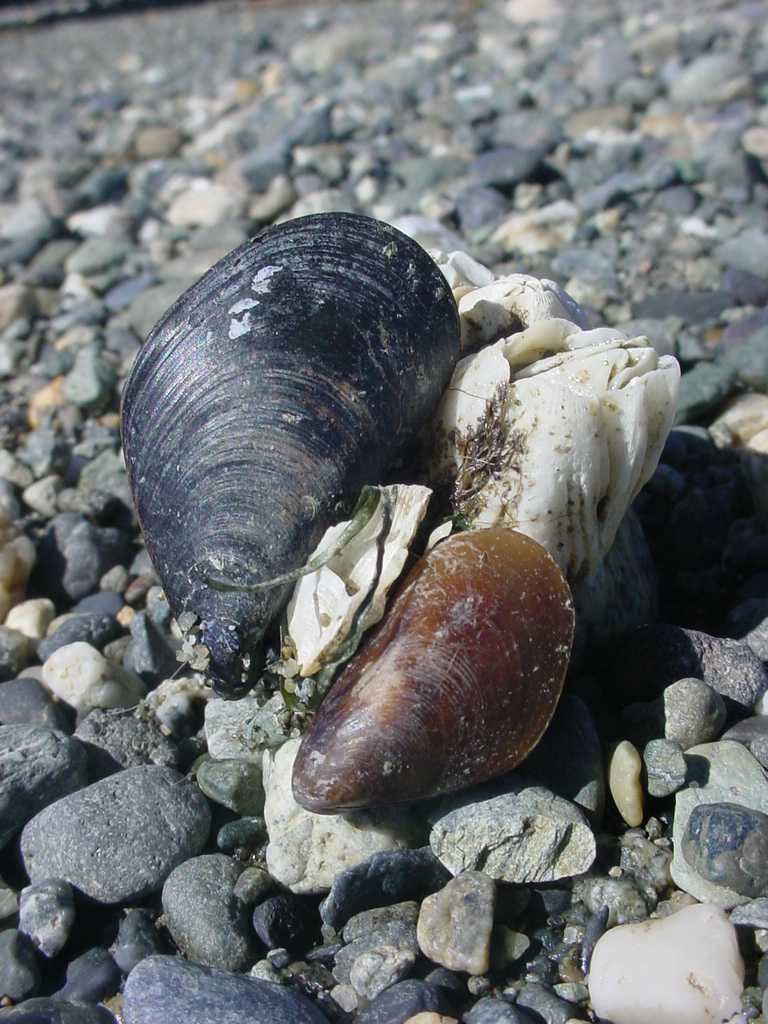
These living mussels are from Ala Spit, Whidbey Island, WA.
The
barnacle is Balanus glandula. Photo by
Dave Cowles, Sept 2005
Note here the two color phases, brown and black, seen in
mussels.
The black phase is usually much more common than the brown.
Nagarajan et al. (2002) found that black oystercatchers optimized their
long-term energy intake by preferentially eating the brown mussels of
the
related species Mytilus edulis.
While shell thickness and tissue content was similar between the color
phases, the brown phase had significantly lower moisture content so
that
the oystercatchers were able
to pack more energy-yielding food into their crops by eating the brown
phase mussels.
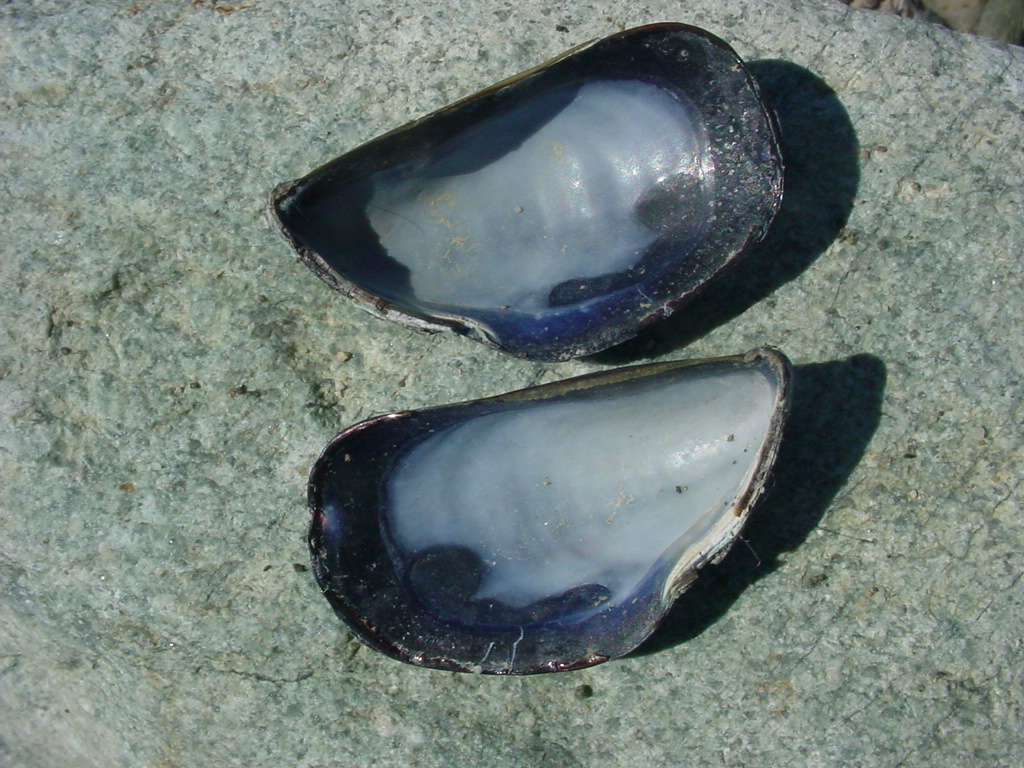
The inside of the shell shows the prominent scar of the posterior
adductor
muscle (at the right side of the top, left valve and the left side of
the
bottom, right valve), while the anterior adductor muscle scar is vary
small
and hard to find.
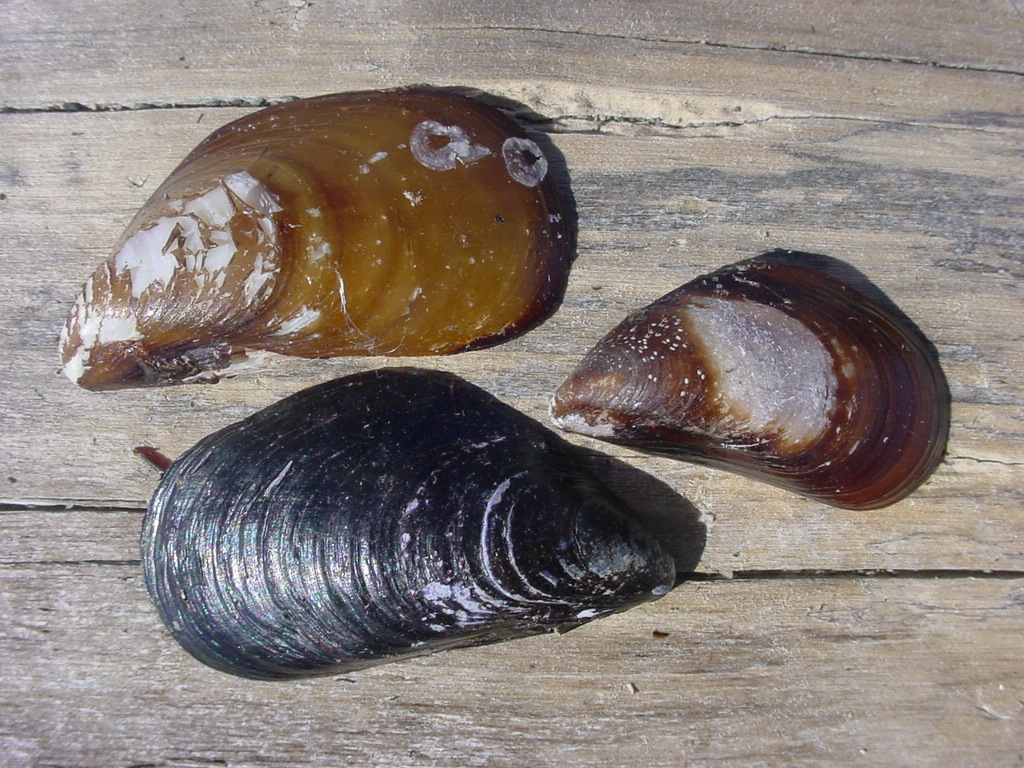
These mussel shells show some of the variety of colors possible with
M.
trossulus. Brown shells are usually small
individuals.
Photo by Dave Cowles, Sept 2005 at Ala Spit.
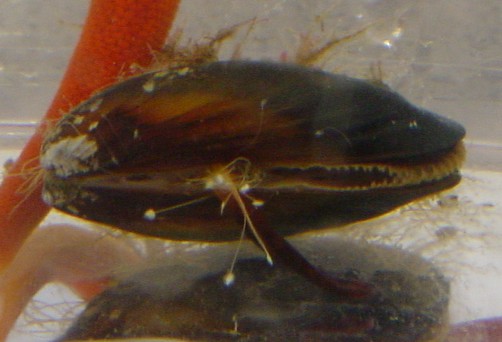
This individual is in the process of secreting a byssal
thread with its foot, and attaching it to the glass floor of
an aquarium.
Photo by Dave Cowles, July 2005
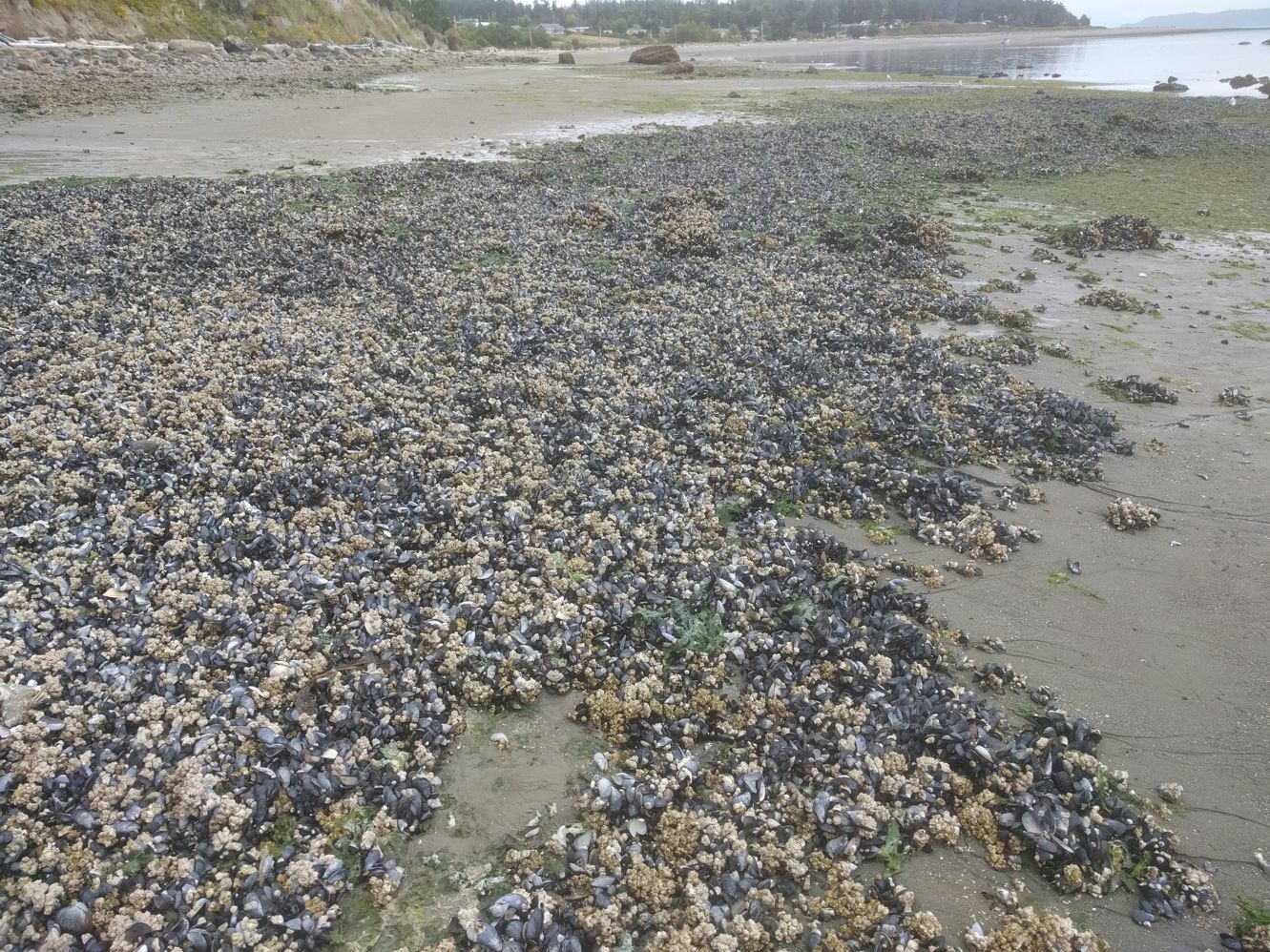
Penn Cove on Whidbey Island, WA has extensive silty bottoms so it is not good habitat for mussle predators such as Pisaster ochraceus.
In intertidal places such as this where a little bit of cobble
substrate protrudes through the silty sand, huge shoals of tight-packed
mussels can be seen. Photo by Dave Cowles, August 2019
Authors and Editors of Page:
Dave Cowles (2005): Created original page